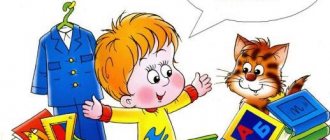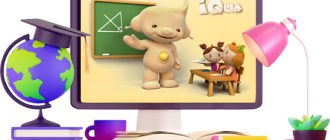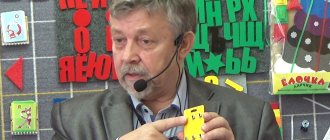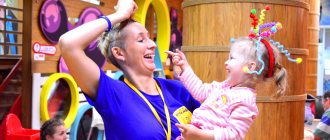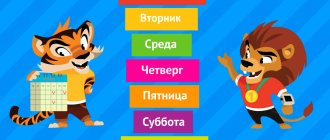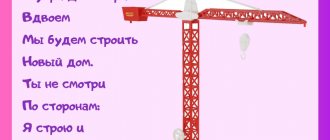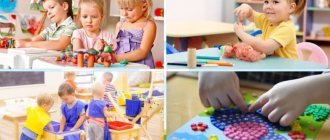February 25, 2019
Averyanova Sveta
Teaching a child to read independently before first grade without the help of teachers and professional skills is difficult, but quite possible. To do this, parents will need teaching aids, books, and methodological recommendations from the authors of the programs. We’ll tell you in more detail how to avoid learning difficulties, when and where to start, what to do if a child refuses to learn to read.
When to start
At what age do you start teaching a child to read? There is no exact answer to this question. Letter literacy lessons are taught at 4–5 years of age, before starting school, at 6–7 years of age.
The age of a preschooler is not the main indicator of readiness to learn new knowledge and concepts. It is much more important how prepared he is for classes intellectually, psychologically, physically. Pay attention to the following indicators, which must be normal to become familiar with reading:
- The baby speaks well and uses common sentences to tell a story or answer a question.
- Phonemic hearing and articulation skills are developed according to age. Pay special attention to the correct pronunciation of sounds; a preschooler must pronounce and recognize all phonemes.
- The child maintains a conversation, clearly and consistently talks about the past day, a significant event.
- A preschooler orients himself in space. Understands the directions right-left, up-down. If the baby confuses the sides, but corrects himself, this is considered the norm.
- A kindergartener can play board games and drawing for more than 10 minutes.
If all of the listed indicators are normal or with minor deviations in a preschooler, he is over 5 years old, it’s time to think about learning to read.
Stimulate unprepared six-year-olds, attract them to the alphabet by your own example, and solve speech therapy problems. If the kindergartener is still very young, 3-4 years old, but asks to talk about letters, teach him how to add syllables, meet him halfway. Conduct classes in an easy mode so as not to discourage interest in reading due to large volumes of information and difficulties in assimilating it.
At what age should a child be taught to read?
Advertising posters that advertise developmental centers often offer cutting-edge methods of teaching children to read almost from the cradle.
But let's think about whether a baby needs such a skill. The answer is obvious - no! At an early age, babies need the care of mom and dad, and not regular “developmental activities.” Experts advise focusing not on the age of the children, but on their individual characteristics. Some kids show interest in books and activities as early as 3 years old, while others begin to look at books and pronounce syllables at age 5. And this is normal, because every child develops at his own pace.
That’s why you shouldn’t be tied to a certain age; it’s much more important to assess whether a child is “ripe” for reading.
Photo: https://pixabay.com/photos/books-boys-forest-park-vintage-2863724/
The readiness criteria are as follows:
- ability to construct proposals;
- a fairly rich vocabulary, understanding of what was said and read by parents;
- clear and coherent speech;
- pronunciation and discrimination of speech sounds;
- the ability to distinguish consonant syllables (ba-pa, wa-fa) and letters in similar sounding words (fruit-raft);
- the ability to navigate in space - right-left, top-bottom (the child needs to be able to follow the text from left to right and top to bottom);
- the ability to concentrate on an activity for 15 minutes;
- expressed interest in letters and books.
Even if the baby does not meet the above criteria in some way, you should not be upset. We need to work more with the child: incoherent speech - we talk to him more and more often; replacing sounds - we turn to a speech therapist for help, do articulation exercises, etc.
Perhaps the most important criterion of readiness from a psychological point of view is the child’s interest in reading and books. If he wants to learn to read, he must not miss the moment and satisfy this request.
Readiness test
Another option for assessing a child’s readiness to read is a test. Go through it with your preschooler and answer some of the questions yourself. Each positive answer is scored 1 point, negative – 0 points.
- Does your preschooler like to be read to?
- Does he listen carefully to someone else's reading?
- Can you retell the text you heard?
- Do you like to look at books on your own?
- Is the content more interesting to the kindergartener than the pictures?
- Does the preschooler pretend to read? For example, reveals his favorite fairy tale and retells it with expression and demonstratively runs his finger along the lines?
- Does he like playing with books and learning the alphabet more than watching cartoons?
- Does a preschooler make toy books or magazines (comics) from scrap materials?
- Does he store and examine children's books carefully?
- Does your child have an extensive vocabulary?
- Does he speak more often in complete, detailed sentences?
- Knows a large number of short poems, fairy tales, songs?
- Can you find a word starting with a given letter? For example, say a word that starts with M (substitute any phoneme).
- Does he know the alphabet, if not, does he want to learn the letters?
- If he is familiar with the letters, does he try to combine them into syllables himself?
- Can he pronounce all sounds well?
- Can you understand the difference between the words CANCER and MAC?
- Asks to teach him to read?
Sum up your points and check out the results:
0–5 points
It's too early for your baby to learn to read.
This does not interest him due to his age and temperament. If a preschooler is under 5 years old, there is no need to be upset or worried, this is normal. Children after 5 years of age with such a test result should begin to be accustomed to books, interested, captivated by pictures, then by content. Come up with a game with collections of fairy tales, read to your little one more often before bed.
6–12 points
The desire for independent reading is unstable. Pay attention to your home library, go to a bookstore together. Buying an interesting collection of fairy tales and stories with bright pictures will help you show more initiative.
Your task is to devote more time to reading, to spark interest in the plot and composition technique. For example, not reading to the end, stopping at the moment of denouement and complaining that he himself cannot read yet, so he will only find out the ending tomorrow.
13–18 points
Congratulations! Your child is ready to read completely, is waiting for new information, wants to receive it in large quantities with the help of books, reading independently. There is no need to put off learning, start today.
On a note! By learning to read, we mean purposeful work to instill the skill of consciously putting together syllables, words and sentences. Children are ready for serious activities at 5–6 years old. Letters and elementary combinations of consonants and vowels can begin to be mastered much earlier, at 2–4 years.
Glen Doman's method of teaching reading
The teaching method according to Glen Doman is popular among modern parents. According to it, you need to start working with the heir or heiress right from infancy. The method is based on showing cards with different images. These can be letters, numbers, animals, plants and much more. It depends on what you want to teach your little one.
As for reading specifically, Doman has his own guesses and statements: the child first needs to memorize the first few dozen words. Mom just shows the picture on the card for a few seconds. There may be many such cards, or there may be few. In general, the technique advises quickly changing pictures.
This technique also has a beneficial effect on the breadth of your horizons. Thanks to Doman, children literally from the cradle begin to master and “study” the surrounding objects and even what he has not yet seen at all.
Whatever method or method you choose, or even a separate manual, there are many of them now, remember one thing - do not rush your baby, let him enjoy a carefree childhood, start classes and serious training when he is completely ready for it! Feel each other...
Stages of training
Even a very inquisitive, gifted child cannot be taught to read spontaneously, unsystematically. The skill will be developed sustainably if you use an integrated approach.
Do not rush to immediately give the concept of a letter, a word, how to add and read them. Use our recommendations for creating a lesson plan.
Development of phonemic hearing and imaginative thinking at an early age
This is extremely important for the perception of sounds, letters, and text. The ability to read begins in infancy, although many parents do it unconsciously.
Play noisy games with your baby, use musical instruments, onomatopoeia. Develop a sense of rhythm with the help of a ball, jump rope, singing, poems. Learn to distinguish between quiet and loud sounds, knocking, humming; there are many options for the development of phonemic hearing.
The last stage is the differentiation of sounds at the beginning and end of a word. A child should answer such questions by age 5. You don't need to know the letters to do this. Name a word starting with C (magpie, catfish), let him come up with a few more similar ones. Then use the last letter. You say HOME, he calls MOM, MOUSE.
It will not be possible to cope with the last task right away. Don’t insist, practice on the way from kindergarten, ask to repeat the correct answer after you, spend more time studying unfamiliar sounds in nature, at home.
Getting to know sounds
Before you get acquainted with the appearance of the letters, tell your child about the sounds. Divide them into several groups. For example, vowels - they can be sung, voiced sounds - show them using the example of sounds of nature (thunder rumbles, a tiger growls), unvoiced ones relate to quiet, non-melodic sounds (shhhh, puff).
At this stage, it is important to form an image, a phonetic shell of letters.
This will help the child perform syllabic and phonemic analysis of words at school.
On a note! To distinguish between voiced and deaf when speaking, use your fingers to your throat. When pronouncing R, D, M and other voiced consonants, there will be vibration under the fingers. When pronouncing deaf words (SH, P, S, etc.) there is no vibration.
Learning and remembering letters
Start getting acquainted with letters by setting goals. Explain why you need to know this. Tell us about the possibilities that the book opens up, about writing, the culture of different peoples. The main task is to interest the baby.
Continue the motivation with simple examples of letters. Start with vowels, for example A, U. The kindergartener will quickly remember them, learn to write, and be able to read the first word: AU!!! When he realizes that reading is not difficult at all, the lessons can be entertaining and fun, move on. Combine new letters with adding syllables and simple words.
Another option for learning about letters is studying with reference to a picture. For this you need primers or ABCs. M - cars, T - cake, V - crow, etc. This method is necessary for visual children. To quickly memorize symbols and write the alphabet, use modeling, coloring letters, and tracing them in copybooks.
On a note! Nikolai Aleksandrovich Zaitsev, the author of the method of teaching reading by letters using cubes, believes that there is no need to teach knowledge about letters gradually. He suggests memorizing the entire alphabet, and then moving on to warehouses.
You can agree with his opinion or not. Focus on the temperament and abilities of your baby.
Adding the syllables
Your baby has learned to combine two vowels and can easily read AU and IA. Move on to merging vowels and consonants. First teach to read open syllables, then closed ones. Make the first words from identical combinations: MA-MA, BA-BA. Use the reverse options: AH, UM, AM, OH.
Show how to sing the syllables. Focus on the fact that the sounds run after each other. This is well shown in the ABC of Nadezhda Zhukova. After this, you can connect several syllables together and put another consonant between them: ZHU-CH-KA.
The easiest way to automate reading by syllables is syllable tables. These are cards with columns of syllables. If you read them daily, gradually accelerating the pace, the child will easily recognize them in words. We advise you to print out syllables for teaching children to read on sheets of paper and give one option per lesson.
Making up words
For this stage, cut cards with syllables will be useful. At first, take 3-4 pieces, then you can have more. Give the task to compose words from the cards received; it is better if there are several options. For example, on the table are the syllables MA, RA, ZI, PO. Let him make up the words: WINTER, TIME, FRAME.
You can download cards with syllables below, click on the picture, download and print.
The next stage is composing words with closed syllables. You will need separate letters and cards with open syllables. For example, MA, PA, SO and the letters on the cards K, F, M. You get the following set: MAC, SOK, PAGE, COM.
After 2-3 lessons, offer to compose words of several syllables. Choose simple lexemes: HOUSE, GRASS, SHOVEL.
After composing words on your own, you can move on to studying books with short texts. First, the baby reads individual words with one syllable, then with two or three. There is no need to rush, scold, or suggest.
Reading the proposals
When your preschooler easily reproduces simple words, move on to sentences. At the initial stage, use familiar combinations: MOTHER, FOREST, WATER, CAT. Select material with short texts of 2–3 sentences. To ensure that the student enjoys reading and does not want to be lazy from boredom, use poems and jokes with meaning. For example:
Vanya has new books!
The son eats the soup himself. Mom is happy.
Teddy bear collected pine cones
And he tore off all the trees.
The next stage is expressive reading of texts of 5–10 simple sentences. Use entertaining tasks, pictures, riddles, and exercises so as not to turn the learning process into a tedious task. Remember, children learn best through play.
Where to start teaching your child to read
- Always start with the simplest thing: gradually learn letters and sounds in everyday life, not in school. We went for a walk: draw letters and syllables with a stick in the sand, fold them out of pebbles, mold them in the sandbox, find letters on clothes, on signs, on food and toy packaging, etc. Explain that letters and sounds surround us everywhere. Tell the difference between a letter and a sound: we write and read letters, but we pronounce and hear sounds.
- When learning to read, a sense of rhythm is very important. The sense of rhythm is well developed by dancing, singing, and outdoor games (games with a skipping rope, ball, etc.). So feel free to turn on fun music and dance. This will not only sharpen the baby’s rhythm, but also lift his spirits.
- Next, you can begin more organized training; you need to gradually teach perseverance and the ability to clean up after yourself. Organize a comfortable table and chair for your child, and a shelf for his accessories (book, notebook, pen, pencil). At first, 10-15 minutes will be enough for training.
- Set a good example for your child, because it is from you that he absorbs the love or dislike of reading. Read more yourself, your child will definitely notice. In addition, discuss with your child what you read, ask him questions about what you read. Young children can be asked questions based on the pictures (Who is drawn? What is he doing?), older children can be asked questions based on the plot. Stimulate them to think (Why did he do that? What would you have done in his place?).
- It is better to teach reading with simple syllables and words and take into account whether the child pronounces sounds in syllables correctly (for example, if the baby does not say the sound “S” or “L”, then you should not teach reading with these sounds, otherwise the incorrect pronunciation will only become stronger). Therefore, it is better to start with words such as: ma - ma, pa - pa, etc.
- Use gaming techniques when learning to read: you can draw vowel letters in red on cards and place them throughout the room, swapping them. Then do the same with the consonants, but color them blue. It is important! The child needs to distinguish between vowels and consonants, this will make the reading process easier.
- Buy an ABC book that is closest to you. N.S.’s primer is in good demand. Zhukova.
- With the help of a primer, the child will learn to first read syllables, and then words. It is very easy to understand, with clear instructions and tips.
- Conduct classes systematically and regularly. 5-10 minutes every day is better than 20 minutes once a week. This can be done at the table, or on the way home, on a walk, in the car, on the train, in a cafe (read signs, name letters, find objects similar to letters, etc.)
- The most important rule is to exercise only in a good mood! No tears or hysterics. It won't do any good. It’s better to postpone the lesson or make an agreement with your child. Now you are watching a cartoon, and then we will read.
How to train a child
So, the preschooler learned to read. It's time to pay attention to the speed of word formation in order to meet the standards of reading technology at school. Use the following exercises to improve your speed at playing passages out loud.
Reading syllabic tables
The table can be printed in large size, click on the image and download it:
An effective means of transition from syllabic to word-by-word reading. If you train regularly, the future first grader will automatically form words from syllables.
Read the tables in columns (vertically), for 30 seconds each at the initial stage. Record the time spent in a diary and note your progress. After 7–10 days, the preschooler should achieve the following result: 3 tables in 30 seconds, that is, he will practically learn them by heart. Train every day 2 times.
Wave
Place the book on the table in front of the child, the text should be small. Let him read at a pace that is convenient for him. Then turn the textbook 90° and ask them to read a passage or the entire text. Then place it upside down and repeat the task. Increase the volume of text gradually.
Reading in passages
The exercise is suitable for children with a medium or fast speech rate. The task of the parent or teacher: to maximize the result. When choosing a training text, take into account your current reading technique and add 30 words to your result. If a preschooler reads 20 words, give the text for 50 units, if 30 words - for 60 units.
The training consists of three stages. First, the child will read the given passage without assignment, in his usual rhythm. Then he tries to keep it within 1 minute, using two attempts. Increase the number of words in the passage when the preschooler calmly and effortlessly copes with the task. Carry out the training every day 2 times (morning, evening).
Retelling the text read
This activity is useful for students with any reading rhythm. Learn to retell what you read paragraph by paragraph, then by page, then completely. If the kindergartener reads very slowly, syllable by syllable, reproduce the text out loud yourself. Let him tell you what he heard and understood. Then he will read it on his own.
Important! At the initial stage of learning to read, prioritize understanding the essence of the text, not the number of words. Move on to increasing speed after practicing automatic folding of syllables and words into sentences.
Teaching a child syllabic reading
The ability of the brain to recognize and remember elements of sign systems, including letters of the alphabet, develops in a child by the age of five. That is why at this age you can already try to teach the first lessons of syllabic reading.
Cards for syllabic reading
At the very beginning, the parents’ task will be to form in the child ideas about letters, which he will later be able to combine into syllables, and these, accordingly, into whole words.
How to effectively teach your child to read? To start learning, you won't need much - just an ABC book and cubes or cards with letters. However, you need to take the choice of textbook very seriously. The material in the book should be presented in detail, consistently and logically. Considering that voluntary attention at this age is most often at the stage of formation, it is very desirable that he retain a maximum of pictures and visual aids. They will complement the basic material well, without distracting the child from it.
Introduction to letters
As we have already noted, the development of reading skills should begin with the study of letters and sounds, guided by the classic principle of “from simple to complex.” It is best to do this in the following sequence:
- Open vowels: A, O, U, Y, E
- Hard voiced consonants: L, M
- Dull, hissing sounds
In the process of learning letters and sounds, you should not rush children, trying to master the entire ABC book in the shortest possible time. On the contrary: each task should begin by repeating the material already covered. This will allow you to consolidate the acquired skills and knowledge as firmly as possible. And develop the correct reading technique in the child.
After the child has learned most of the letters and sounds, you can move directly to syllabic reading. To make it easier for a child to assimilate unfamiliar and still incomprehensible material, it is convenient to conduct classes in a playful way.
Zaitsev's cubes for syllabic reading
For example, by dividing a syllable into letters, you can imagine how one letter “runs” to another, after which they begin to be pronounced together. The first syllables a child learns should be simple and consist of two sounds. It is desirable that the consonant sound comes before the vowel; syllables in which the vowel sound comes first, as well as syllables with sibilants, are best left for later. Having understood the principle by which syllables are formed, the child will no longer experience difficulties in the future.
Having mastered syllables, the child can move on to reading simple words. These can be words made up of simple or repeated syllables. Over time, words to read may become more difficult.
In the process of teaching a child to read, it is important to strictly monitor his pronunciation at every stage. The child must maintain pauses in words, observe intonation and emphasis.
Lessons should be done daily
Even if learning progresses at a slow pace and the child has difficulties, you should not rush him by accelerating the pace of classes. Let reading be, first of all, an interesting and exciting game for him. Children whose parents are overly concerned about the speed of their learning are more likely than others to have speech therapy problems and difficulties with self-esteem.
Useful tips
Teaching children to read can be a struggle for first graders and their parents. To avoid scandals, disappointments and not discourage your desire to master literacy, use these little tricks:
- Exercise regularly. Lessons conducted sporadically or poorly organized will not give the desired effect. The child will simply forget all the information. Make a study plan and follow it strictly. Sometimes take a vacation for a couple of days.
- Learn through play. For example, build houses from letter cubes and transport them on a truck to form syllables. Without strict rules and sitting at a table for 30–40 minutes, information will be absorbed easily and with interest.
- Follow the sequence of training. The plan may look like this: sounds - letters - syllables - words - sentences - texts. Move from simple to complex consistently.
- Use video tutorials to practice at home. This option is suitable for older preschoolers; use it for self-education for parents.
- Review what you have learned regularly. Use different methods for this: print out cards, make drawings, learn riddles, songs.
- Look for letters everywhere.
To practice reading, it is not necessary to have a book or blocks at hand. During a walk, ask your child to point out familiar symbols on the bulletin board, on the price tag in the store, on house signs. This is a great practical experience. - Don't force reading if your child doesn't want to study. You definitely shouldn’t teach syllabic reading to 3-4 year old children, they don’t need it and aren’t interested. It’s time for preschoolers, 6–7 years old, to learn to read. But if the kindergartener doesn’t want to, use different methods of motivation to revive interest: your own example, rewards for hard work, praise.
How to teach a child to read while playing
- In order for your child to better remember the letters, make them yourself and better than using rough paper. This way, the child uses not only vision, but also tactile sensations. Moreover, when the child himself participates in the production, he understands the world better.
- Learn one letter in different ways: drawing in the sand, laying out cereals, pebbles, modeling from plasticine, drawing with your left and right hands...
- Give a special massage. Write a letter on the child’s back and he guesses. You can change places, because the baby is interested in giving tasks himself.
- Hang the letters and written words around the room and pronounce them. Letters and words should be bright and written in two colors (vowels in red, consonants in blue). This is necessary to make it easier for the child to learn the rules of grammar.
- For this game you will need a magnetic board with letters, or a refrigerator with magnetic letters. Place several consonant letters vertically, those sounds that the child pronounces well. Place one consonant next to it. This is an elevator where the vowel letter rises and falls. At the same time, we read the syllables (first the adult, and then the child). For example, MA - PA - TA - NA. Then you can replace the letters in the elevator and put vowels, and the consonant will rise and fall.
- When the child masters reading straight syllables. you can go to the reverse. For example, an airplane is the letter A. The airplane lands at different airports and the syllables are formed: AN; AP; AM...So the baby will understand. what are back syllables and learn to read them. First, of course, the adult reads, and the child listens. Next, you need to introduce it to repetition.
- You should not play the same games every day; you need to alternate them so as not to lose interest.
- It should be read emotionally and not monotonously. Read as if in a chant, emphasizing the accents. First, the adult reads, and the child listens, then repeats.
- Make sure your child finds it interesting. If interest is lost, then you should stop so as not to discourage desire.
You will also be interested in the educational educational video Luntik learns letters . The video will help you quickly and easily learn letters and prepare your child for school.
Games and exercises
To memorize letters, syllables, develop memory, and attention, it is useful to use a variety of games and exercises. They help overcome fears, doubts, and automate reading skills.
To learn letters
- Together with your child, create a collection of homemade letters from paper and plasticine. Play with crafts, try to add syllables, name the sound they represent.
- Memorizing poems, songs into individual letters, sounds.
- Letter lotto.
- Who is bigger? The one who remembers more words starting with a given letter wins. You can use the opposite option: we name words that end with a certain sound.
- Say the opposite! Speak short words (mouth, poppy, house). The child must say them backwards.
- Spell the word. Take small word forms into parts, naming the sounds: D-O-M.
For learning to read syllables
- Make up a word. You will need cards with syllables and letters. The child himself will select the desired option and read it. You can add pictures to the task, then the child will make up a word on a given topic.
- We are looking for short words in long ones. From the letters of the word TRUCK you need to make one-syllable words: load, call, circle.
- Table walkers. Draw a movement diagram, write syllables in the cells. The child reads the chips every time he moves.
- Search for syllables in texts. Take any work of art, a fairy tale. Let him look for a familiar syllable in words, circle it with a pencil. If you manage not to miss a single syllable in the passage, the student receives a reward.
To develop reading skills
- Find the extra or missing letter. Write the misspelled words: GU-ZO-VIK (the letter P is missing), YAM-BLO-KO (the M is extra). The exercise develops attention and spelling vigilance. This will be very useful in Russian language lessons in first grade.
- Make a menu. The child becomes a cook and creates a menu for the family for the day. His task is complicated by the fact that dishes must begin with the same letter, for example K.
- What do you see with the letter..? Think of any phoneme, ask the student to name all the objects that he sees around him that begin with this letter (K - books, cat, pan, etc.).
- Who is faster? Write words starting with one letter on a card: chalk, moth, soap, honey, stranded. The goal is to read the list the fastest. Reading speed, attention, and mental abilities develop.
Are you ready to teach your child to read?
The child may be ready to learn, but are you ready to teach him yourself? Naturally, you don’t have to be a teacher, but you definitely need to pay attention to two important points:
- First, think about whether you yourself remember the alphabet exactly, and whether you are confused about the names of the letters. For self-test, take any reference book. If you notice that you yourself say something like “le”, “me”, “ne”, etc., it’s worth working on these points, because the correct pronunciation is “el”, “em”, “en”, etc. Also consider whether you recognize the difference between letter names and their sounds in words. It is very important to understand that depending on the environment with other letters, the same letter can sound differently. Soon you will have to tell your baby all this, so figure it out yourself.
- Secondly, are you ready to teach your child from the point of view of pedagogy and psychology? Of course, if he learns everything quickly and immediately, this is very good, but if you are faced with the need to talk about the same thing 20-30 times? Understand that when teaching, you cannot take a rigid parental position, saying, “What’s incomprehensible here?”, and you should always remain calm, patient and friendly. So here, too, you should be extremely careful, and if you feel that you are not yet ready to start teaching your child independently, then you should wait a little.
If you have taken everything into account and feel confident in yourself, then you can start learning. And now let's talk a little about several methods with which you can start teaching reading to little ones.
Basic techniques
There are really many methods for early learning to read. They can be divided into traditional and non-traditional.
The first ones, easy to use at home, are suitable for children from 5–6 years old. These are ABC books.
The second ones are universal and can be used at an early stage and closer to school age. These are cards, cubes.
To master the teaching methodology in a non-traditional program, you will need deep knowledge of child psychology, sound features of vowels and consonants. Let's take a closer look at some of the author's methods.
Primers and ABCs
They are convenient because the child learns letters and sounds at the same time, gradually putting them into syllables, then into words. Each alphabetic character is accompanied by a picture. An elephant is drawn next to the letter C, and a watermelon is drawn next to the A. Syllability goes parallel to memorizing letters. That is, the set of phonemes for reading increases in the process of recognizing the alphabet.
There is an opinion that this method of teaching reading is too complex, requires perseverance, and is suitable for children with a great thirst for knowledge. But he was the main one in the Soviet school.
The arguments against book learning can be argued. For example, Zhukova’s primer clearly shows children how to read sounds together without naming them separately.
The ABCs are accompanied by bright pictures and plot drawings based on the text. By the end of the course, the preschooler will read not only syllables, but also large passages, know what a syllable is and stress. It is impossible to achieve such a result with the help of cubes and cards alone.
On a note! In addition to the primer by Nadezhda Zhukova, textbooks for teaching reading from an early age by Dmitry Fonin, Vseslav Goretsky, and Nadezhda Betenkova are popular among teachers and parents.
Voskobovich's tower cubes and folding cards
Cards with pictures are intended for teaching children from 3-4 years old. They have bright pictures and warehouses painted on them. The cards come with a CD with songs, the text of the verses is written under the pictures. First, the child sings the words, then finds them in the text and gradually learns to read.
Voskobovich's tower cubes are designed for kindergarteners over 4 years old. The set consists of 12 cubes with a cavity with consonants written on them, and 12 cubes with vowels. The child’s task, after becoming familiar with the Russian alphabet, is to create a warehouse with which any word begins. This can be one letter or a pair.
Then syllables are studied. Children match the vowel to the consonant and assemble a syllable from two cubes. Then words are made from several cubes.
Zaitsev cubes
Zaitsev's method is based on reading by syllables, do not confuse it with syllables. A warehouse can consist of one letter or several. For example, in the word SANKY there are 3 warehouses: SA-N-KI, in the word MAMA there are 2 warehouses: MA-MA. According to the author, it is easier for a child to learn to read by words than by syllables. And this is confirmed in practice.
The training set includes 52 cubes: all the letters of the Russian alphabet, combinations of consonants and vowels. They are different in shape, filling and tactile sensations.
For example, voiceless consonants are indicated on cubes with pieces of wood inside, while voiced consonants are filled with metal parts. That is, the child does not know that this letter is voiceless or voiced, but hears what type of sound it makes. Additionally, tables for warehouses, audio cassettes with songs, and a manual with descriptions of lessons are used.
In the form of a game, the child gets acquainted with the alphabet, and with the entire set of letters at once. Then he independently combines them into words, smoothly sings the lines with the help of special chants, and works with the table.
The Zaitsev teaching method is suitable for children who do not like and cannot sit still for a long time. Static lessons can be easily replaced with a dynamic game.
Chaplygin cubes
Suitable for children from 4 years old. The set consists of 10 cubes, 10 blocks. The preschooler spins the cubes, looks for the necessary syllables, and reads them. Then he makes up simple words. Simultaneously with reading, the outline of letter symbols is learned.
During the game, motor skills, thinking, memory, and attention are involved. According to parents and teachers, this technique is effective and easy to do at home.
Doman cards
The author of the program, American doctor Glen Doman, suggests teaching children to read whole words when they do not yet know letters and do not even know how to speak. Parents need to purchase a set of cards, show them to the newborn for a couple of seconds, pronounce what is written, quickly changing to the next one.
In the first lessons there will be 15 of them, then the number increases. New material is presented after repeating what has already been covered. At 1.5–2 years old, the child will be able to say for himself what is written on the card.
According to psychiatrists and neuropsychologists, the Doman card training system is based not on reading, but on automatic memorization of visual images. If you offer a child a word that has not yet been shown to him, he will not be able to read it.
Method of reading syllables by Elena Bakhtina
The author's methodology is based on syllabic reading. The child is offered cards with letter combinations. The student must read them fluently and recognize them automatically. Then you can start composing words and texts.
For ease of memorization, the letters on the cards are painted in different colors: blue - consonants, red - vowels, ь, ъ - black. Read open and then closed syllables first. Leave combinations of vowels and sibilants for the last stage, they are much more difficult to pronounce.
On a note! You don’t need to look for books and educational kits in the store. Order them online. There you can also read reviews from parents and early development center methodologists about practical experience in using each program.
Reading using the Doman method and our not very successful experience
Of all the methods, reading according to Doman seems to be the most unusual for our understanding. In this system, whole words, many words, are shown to the baby at a fast pace on cards! According to Doman, the child very quickly begins to remember the spelling of the words shown to him and gradually comes to read them. “But it’s impossible to remember all the words of the Russian language!” - you must be thinking now. However, Doman argues that in the process of repeated exposure, the child does not just photographically remember words, he learns to analyze their composition. And after looking at a lot of words, the baby soon begins to understand how the word is constructed, what letters it consists of, and how to actually read it. And, having mastered this, he will be able to read not only the words that you showed him, but also absolutely any.
For a very long time I was skeptical about reading according to Doman, it seemed completely unnatural to me, but nevertheless, the example of those children who learned to read using this method pushed me to start classes. Since I doubted it for a long time, my daughter and I started only at 1.5 years old (Doman recommends starting at 3-6 months). Indeed, soon after the start of classes, the daughter began to recognize the words shown to her. All I had to do was put 2-4 words in front of her and ask where it was written, for example, “Dog”, she showed it correctly in 95% of cases (even if I asked her about words that she had not seen before!), but the daughter herself read never started. Moreover, it gradually began to seem to me that the further we moved, the harder it became for her. More and more in her eyes I saw an attempt to guess, and not to read.
If you look for reviews about the method on the Internet, you will meet both people who are completely disappointed in the method, and those who really taught their children to read and not read easily, but at a fairly decent speed. And here’s what I noticed: all the people who have achieved success in this difficult task have one thing in common - they started classes very early, up to eight months. It is this age that Doman calls optimal, and it is no coincidence: the younger the child, the better developed is his ability to perceive the image of a word as a whole, gradually this ability is lost, and closer to 2 years the child increasingly needs a letter analysis of the word.
So, it would be wrong to call the technique complete nonsense, as many immediately do. The mass of children who have learned to read all over the world speaks in its favor. But I won’t persuade you to take it, because Taisiya never learned to read from it. I can only say one thing: if you haven’t started Doman classes before the age of one, then don’t start, don’t waste your nerves or your child’s.
Books on the topic
There is no way to do without books and collections of texts when teaching reading at home. Please take a look at the following collection of useful tutorials.
Fedina Olga and Sergey “How to teach a child to read”
Textbook for preschoolers from 4–5 years old. The authors of the methodology took as a basis the syllabic method, which, according to parents, is the most effective and easiest way to teach reading. The book comes with useful tips for conducting classes; the lessons are divided into blocks, each accompanied by bright pictures.
Uzorova O. V., Nefedova E. A. “100 educational texts for teaching children to read”
The collection of texts is suitable for preparing six- and seven-year-old children for school. The educational material is accompanied by entertaining tasks and exercises for developing horizons, memory, attention, and fine motor skills. For ease of reading, words in the text are divided into syllables by vertical bars. Short stories are dedicated to the animal world, fish. There are coloring pages at the beginning or end of the text.
Baranova E. E., Razumovskaya O. K. “How to teach your child to read”
The collection of tasks is suitable for children aged 4–5 years. The authors use the syllabic method of teaching reading and invite children to play train with letters. You need to cut out a paper toy from a book yourself, put cards with letters in it and play with syllables. Classes are held in a playful way, so information is remembered quickly and easily.
Zhukova N. S. “Primer”
The textbook is based on the traditional syllable-by-syllable reading method. You can start lessons without knowing the sounds and letters. Learning the alphabet goes parallel to the formation of the skill of putting letters into syllables. The book is written in large print and illustrated with bright pictures. Zhukova’s primer is recommended by the Ministry of Education of the Russian Federation and has been used in kindergartens and development centers for more than 10 years.
Learning letters from the alphabet
Alphabet books, cubes and other toys, where each letter is accompanied by a picture, are almost mandatory purchases for a child. With their help, many parents begin to introduce their child to letters quite early and by the age of two they can boast to their friends that their child knows the entire alphabet. Only after this, the matter does not progress any further, having learned all the letters, the child for some reason does not begin to read. “He knows letters, but doesn’t read” - you must have heard about this problem, and maybe you yourself have already encountered it.
The fact is that when you and your child repeatedly look through the beautiful pictures placed in the alphabet next to the letters, and repeat “A - watermelon”, “N - scissors”, strong associations between the letter and the picture appear in the child’s mind. A very specific image is assigned to a letter, which then prevents the letters from being combined into words . So, the simple word “PIT” turns into “Apple, Ball, Watermelon.”
It’s even worse if, when showing their child letters in the alphabet, parents pronounce not the sound that corresponds to this letter, but the name of the letter. That is, not “L”, but “El”, not “T”, but “Te”. Needless to say, the child does not understand at all why “Es-u-um-ka-a” should suddenly turn into “Bag”. It’s sad, but this is precisely the pronunciation of letters that is found in all sorts of “Living ABCs” and sound posters. If you still teach your child individual letters, then pronounce only the sound that corresponds to this letter . But before you memorize individual letters, familiarize yourself with other methods of mastering reading.
Mobile applications and simulators
If it is impossible to sit the baby down with books, they do not like to play with cubes or cards with letters, use interactive simulators to teach reading. You can download them to your tablet, mobile phone (iPhone and Android), play at home or on the go.
Luntik. Let's learn to read!
With your favorite cartoon characters, your child will learn to recognize letters, put them into syllables, and read words. The application is suitable for both one-year-old children and future first-graders. The program is divided into 10 levels: 4 simplest and 6 more difficult.
Talking ABC
The preschooler will learn the alphabet with the help of songs and plasticine helpers. Bright animation and fun games make lessons entertaining and not boring.
Learning to read by syllables
The application is designed for kindergarteners aged 5–7 years who know letters. The teaching methodology is based on Zaitsev’s program. Users make words from warehouses, cards with letters and syllables. With the help of simple games and entertaining tasks, the future schoolchild quickly learns to read and divide words into parts.
ABC for children! Let's learn the alphabet!
The letters are hidden in colored boxes with pictures. The task is to catch them and form a word. The game is designed for children aged 2–3 years in the “Learning Letters” mode, and preschoolers aged 4–7 years in the “Read by Syllables” block. The app has received a lot of positive feedback from parents.
Learning letters is fun!
The program is useful for kindergarteners unfamiliar with the alphabet. The games are divided into three parts. In the first, the child gets acquainted with letters using pictures, learns to pronounce them, and recognize them. In the second, he consolidates the acquired knowledge and composes words. In the third, smart coloring pages and favorite cartoon characters await him. You need to color the pictures using letters.
With the help of computer games, even a weak child can learn the alphabet and learn to read syllables, words, and sentences. In addition to educational exercises, the educational site has a lot of tasks to develop attention, memory, and reaction speed.
Rules to help teach children to read
So, the child is psychologically ready to master a new skill. Moreover, he himself reaches out to books, he loves listening to fairy tales and wants to learn to read, so as not to ask his mother about it. So, you need to start learning.
But only correctly, taking into account the recommendations of specialists and experienced parents.
- My own example. If parents love to read and constantly sit up with a book in the evenings, there is a high probability that the child will be drawn to reading. On the contrary, if adults prefer to sit on the computer or watch TV series, the baby will put the book away.
- Beautiful illustrations. The first books to read should have bright illustrations that will attract children's attention. In addition, plot pictures will help the child follow the intrigue of the fairy tale.
- Shared reading and discussion. Be sure to read books to your child regularly, turn reading into a kind of evening ritual. At the same time, you can and should be interested in children’s opinions about what they read.
- Search for letters. Letters are found everywhere: on magazine covers, on store signs, on street advertising. Draw your child's attention to this fact and ask him to find a familiar letter or word on the sign.
- Games with letters and words. There are a great variety of similar games: searching for a word starting with a given letter, letter lotto, composing short words from longer ones, tracing the outline of letters with your finger, laying them out from scrap materials.
And, perhaps, the main recommendation from experts. Never force a child to read if he does not want to. This is especially true for young children who are simply not ready for such systematic activities. But you should also look for a special approach to a reluctant preschooler - encouragement, praise, joint games.
Answers to frequently asked questions
How long does it take to teach a child to read?
Learning to read from scratch can take 6-8 months with a 4-5 year old child. An adult child, 6–7 years old, masters the skill faster, in 3–6 months. If you attend classes at a development center, a tutor, and read additionally at home, the period is reduced to 2–4 months.
Although in this video you can get acquainted with the real story of how a child was taught to read syllables in 2 hours.
How to teach reading if a child doesn’t want to?
A categorical refusal to study with books, tables, and cubes can be overcome by increasing motivation. Interest a reluctant woman in a bright book on her favorite topic, tell her why it is useful and necessary to be able to read. Look at pictures in books every day, read in the evening, during the day, discuss the plot.
When the first signs of interest appear, try playing with letters, solving puzzles, and using coloring books.
Can a child learn to read on his own?
This option is possible if there are older children in the family. The kid watches homework being done and begins to imitate the school students. When it turns out that the baby has learned the letters himself, parents only need to speed up the process a little.
Buy an ABC book, give some theory, apply several speed reading methods. If a preschooler is inclined to self-education, is diligent, and will show good results.
Should educators teach children to read?
Reading lessons are not included in the mandatory kindergarten curriculum. Teachers in the preparatory group can give a small amount of information about sounds and letters.
Reading is taught in elementary school. The exception is specialized or private kindergartens, where parents pay for additional classes in preparation for first grade.
How to quickly teach reading syllables using Zhukova’s ABC book
At 3-4 years old, the baby is not yet psychologically capable of learning. Children aged 5 and 6 years perceive classes completely differently. Although kindergartens teach the basics of reading, some children need individual instruction so that they can better understand the formation of syllables.
Among the variety of techniques for teaching reading, Nadezhda Zhukova’s method is extremely popular.
She created a special method with which children quickly learn to read and easily move on to writing. It has been proven that it is easier for children to identify a syllable than one sound in a spoken word. It is this principle that forms the basis of Zhukova’s method.
There is no need to learn the entire alphabet at once. First you should learn only the vowels. We need to explain to the child that these letters can be sung. Having become familiar with the vowels, they are added together: AU, OA, OU. Let the child independently, using his finger, move from letter to letter and sing them. Then you can start studying consonants.
During the lesson, it is necessary to explain how to determine by hearing how many sounds the parent made, which sound is first, second, last.
Zhukova’s “Magnetic Alphabet” can help with this, thanks to which the baby will lay out the syllables spoken by adults.
It is recommended that during classes, ask the young student to trace the letters with his finger, because this promotes tactile memorization. “The Primer” by N. Zhukova will help any adult, even without pedagogical education, conduct a lesson.
See also:
How to teach a child to count examples within 10 and 20?
